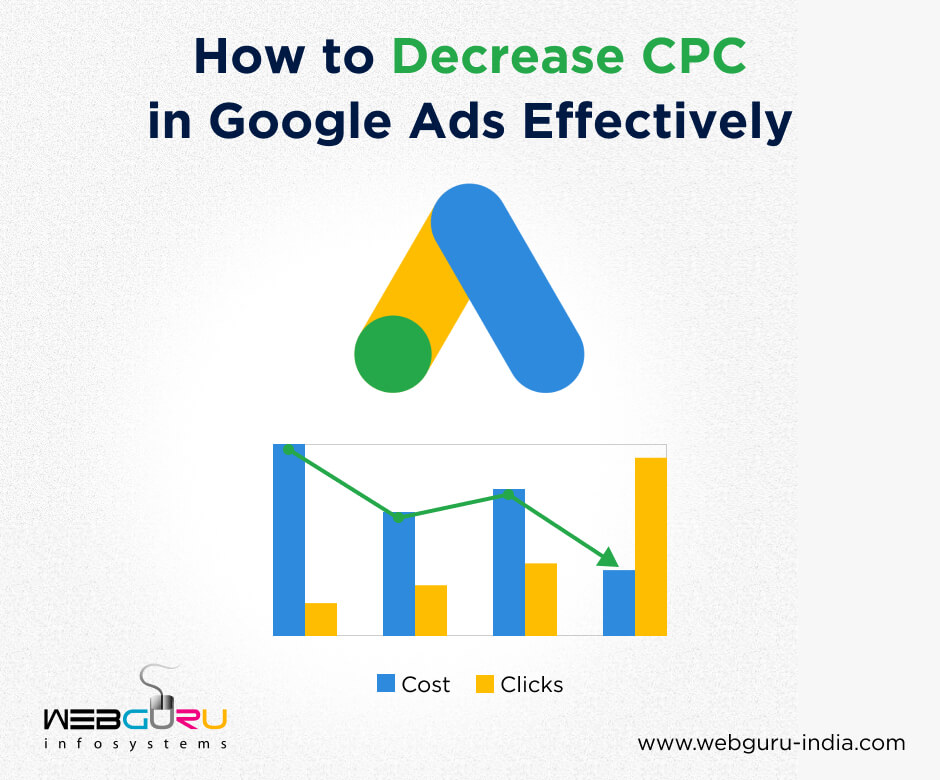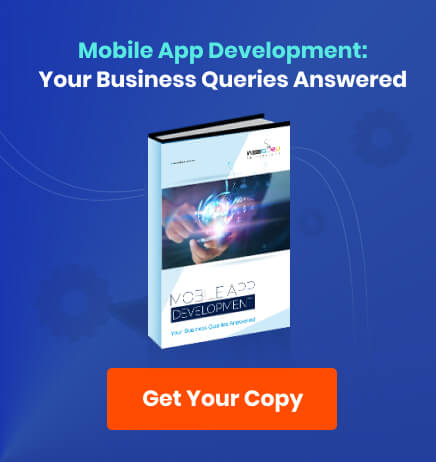Home Blog Digital Marketing Services How to Decrease CPC in Google Ads Effectively
How to Decrease CPC in Google Ads Effectively
- 30 Jul / 2022
- 2,478 views

A majority of businesses are involved in PPC advertising, and Google Ads is the most popular PPC platform available today. Among all digital marketing services, PPC serves to provide immediate tangible results. And businesses are constantly concerned on how to get maximum returns from their ads, while not over-spending through advertising budgets. A good cost-effective campaign means ads with low cost-per-click (CPC). However, lowering CPC is easier said than done. Let us have a look at effective Google Ads strategies in which you can reduce your CPC.
8 Effective Ways to Lower CPC
Lowering your CPC requires insight into your audiences, your bidding strategies, and the relevance of your ads. Here are 8 strategies PPC management services effectively use to get a lower CPC.
1. Better Match types
Consider using new match types for your keywords. This means you will have to do research on your targeted field or industry, and find relevant keywords for yourself. You’re likely to find slight differences in the CPCs for the exact same keyword using different match types. It’s always a good idea to experiment in this area.
You must remember that broad match types generally attract more traffic, since they tend to be much less restrictive. When you look at your search terms, you’ll notice that you are getting clicks for queries which include similar phrases to your campaign keywords, but not the exact same ones. This is why Broad Match types tend to be slightly less expensive than Phrase Match or Exact Match keywords. Each of these approaches has its own benefits, so it might be worth trying them out to see which one works best for you and your brand. You can try them all out, and then scale up on the match types that are proving beneficial.
2. Search Term Audits
It is important to note that Google’s specifications have changed for these match types, and instead of focussing on the keywords themselves, Google now focuses on their meaning. Broad match type ads will show up on queries that relate to your keyword, Phrase match type ads will show up for queries that include the meaning of your keyword, and Exact match type ads will show up for queries that have the same meaning as your ad. This essentially means that search queries no longer have to have the exact same words as your keywords even for an Exact match.
This might become a problem when your ads start showing up for queries that don’t corroborate with your products or services. This drives up costs per click as well. A good way around this is conducting a search terms audit often, to see what searches are triggering your. From there, you should select the necessary terms and add them to your negative keywords list. This way you can let Google know what search queries not to show your ads for.
3. Leveraging Exclusions
Similar to the negative keywords list, Google also lets you choose exclusions for all your campaign types, like location. You can use the location exclusion in order to prevent Google from showing your ads in locations where you know you won’t get conversions. There are several Display Ad-specific exclusions that you should keep note of as well. There could be certain types of pages or topics that you think your ads wouldn’t be a good fit for. There might also be certain specific audiences you don’t want to show you display ads to, for example you remarketing or converting audiences. Similarly, you might also not want your ads to be placed on certain types of apps like mobile gaming apps, that could lead to plenty of accidental clicks.
4. Long-tail keywords
These are general phrases containing 3 or more words. They have significantly less search volume as compared to shorter ones, which means they will have significantly lower competition for bidding as well. When compared to broader and shorter keywords, they prove to be significantly less expensive. Of course, it might also mean less visitors to your website, but you will certainly gain a higher visibility among the long-tail keywords you choose. Since they are more specific, they can also improve your chances of a conversion. For example, someone searching for “men’s shoes” is far less likely to actually make a purchase than the user who searches for “black leather shoes for men”. Someone that types in this longer keyword already knows what they’re looking for, and therefore further along in their buying decision already.
Here are a few simple ways in which you can find long-tail keywords:
- Use the Google Ads Keyword Planner. This tool lets you easily map search volumes and estimated CPCs to any keywords.
- As with the previous step, conduct regular search term audits. This will introduce a lot of new possible keywords that users are searching for that you may not have considered.
- When you type in a keyword on the Google search bar, you get a dropdown with suggestions to finish your phrase. These are commonly searched keywords, and you can try putting some of them in the keyword and find an estimate of CPCs and search volumes.
- Almost 85% of Google searches receive the “People Also Ask” section. This feature lets you understand what people are asking for, and is a great way to find newer longer keywords.
- The SERP footer also displays search terms that are similar to what you’ve searched for. This is also a section you may effectively use to figure out what people are searching for.
5. Better Bidding Strategies
You may wish to consider changing your bidding strategies as well. Google offers multiple kinds of bidding strategies, including some automated bidding strategies as well. These include strategies like better CPC, more clicks, more conversions, target CPA, and a few more. Many advertisers don’t go for automated bidding strategies, as they like to have the maximum amount of control over CPC numbers. However, as long as you have enough conversion data in your Google Ads account, you should feel free to choose one of the many semi-automated bidding strategies that Google offers.
Our primary focus here is the automated strategy of Enhanced CPC. With this, you provide Google information about the maximum amount you’re willing to bid for any keyword. Then, based on your parameters, an algorithm will optimize your ad delivery for you. This saves you considerable time and effort you would otherwise have to spend monitoring your ads and CPC. Of course, since it is a semi-automated process you will still have to keep an eye on the process. This is because the algorithm will require some time to go through its learning phase and get you the best results. You will need to make sure that your bid amounts do not increase and your conversions don’t suddenly go down while the algorithm learns the ropes.
6. Quality Score
Quality score is essentially Google’s rating of the quality of your ad. This is calculated through the relevance of your keywords, your CTR, the quality of your landing pages, and your SERP performance in the past. It can significantly impact the position of your ads on the SERP, as well as how much you end up having to pay for each click. The better your quality score, the higher your ad can rank, and the lower your CPC becomes.
When your ad-to-keyword match improves, your ad relevance also improves. This is another major factor in calculating your quality score. Similarly, when you match your landing pages to the keywords, your landing page experience also improves, which is another important component in deciding your quality score.
7. Smartly Written Responsive Search Ads
From June 2022, Google has stopped Expanded Text Ads for marketing. Now advertisers only have Responsive Search Ads to show up on the Google search results. Google requires you to enter 15 titles and 4 descriptions, from which the algorithm will randomly choose and create headline and description combinations for your ads. Google makes this decision based on the number of impressions and clicks each of your titles or descriptions get, based on which it decides the strength and relevance of your ad.
A big consideration for your Ad Strength indicator is the number of headlines and descriptions you provide. It might be difficult to come up with 15 headlines, but not only is it helpful for Google’s split-testing, it is also important so that your ad strength stays up. However, during this testing and learning period, Google might create headline combinations that make no sense, or otherwise misrepresent your services. Which is why it is very important to write out your responsive search ads very smartly. Consider following these tips for writing your ads:
- Add necessary headlines
- Avoid any redundancy
- Make sure all the combinations make sense as far as possible
- Highlight your key-value propositions
- Be smart with your keyword insertion
- Pin your USPs so they always show up
- Keep tracking the performance of all your assets
8. Convincing Landing Page
The “above-the-fold” portion of landing pages is where most businesses lose the maximum number of customers. This refers to the portion of the page that’s immediately visible before the user has to scroll. This means not only does the design have to be really good, it must also include a copy that speaks to the user and makes them want to journey through your website. A convincing landing page design and copy will not only drive traffic that will offset any CPC, it will also significantly reduce cost-per-conversion as well.
Conclusion
As you may have noticed, decreasing your CPC generally basically includes refining both your ads as well your audience in order to get rid of wasteful ad spends and unnecessary clicks. The better your understanding of your audience and their wants, the better you can craft ads that will reach your ideal clients, and the better your CTR and lower your CPC will be.

Priyanka Agarwal
An expert digital marketer with vast knowledge in SEO, SMO, and the like, Priyanka Agarwal writes about the latest trends in digital marketing.
6 comments
Leave a Reply

-
1000+
Happy
Clients -
25+
Countries
Served -
19+
Years of
Trust








Awesome! Great information for those who are new to PPC ads.
Nice read… it provides some insights on how you can lower CPC in Google Ads and every point is explained in a detailed manner.
Google Ads have become the go-to avenue for businesses to drive traffic to their websites. The blog on the top ways to reduce CPC in Google Ads has encapsulated the vast subject quite effectively.
Insightful article. This should help manage ads a lot better.
I loved your post.Much thanks again. Cool.
Great insights on reducing CPC! Focusing on improving Quality Score through relevant ad copy and optimized landing pages is crucial. Utilizing long-tail keywords and negative keywords can also help target the right audience while avoiding wasted clicks. Regularly testing ad creatives and leveraging automated bidding strategies are key to ongoing success.